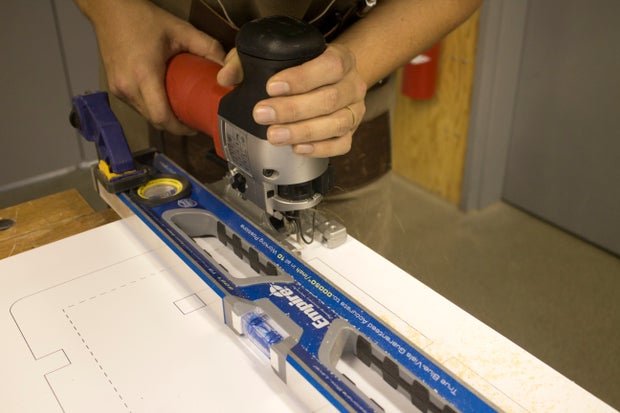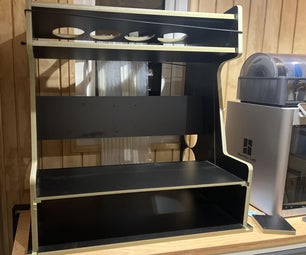Introduction: Flip-Top CNC Table

Space is expensive, space saving is not. With this table in my garage, I have a 30 square foot work table and on the under side, a 33" X 33" Shapoko XXL CNC machine when I need it.
The CNC machine is screwed to the underside of the table top, which is attached to two side shelves with shafts and bearings. Four set screws keep the table rigid when it's in either position.
Step 1: Live Q+A on Maker Project Lab
Donald Bell recently hosted me on his Maker Project Lab youtube channel. We talked about the design, fabrication options, and some ideas on how to improve it for the next round.
Step 2: Tools + Materials
At Pier 9, we've got all the awesome tools. I made this project using our Shopbot CNC.But don't worry, you don't need those fancy tools to make this project.
4'X8' CNC Machine
I used the Shopbot at Pier 9 to cut these pieces because it's big enough to fit a 4X8 sheet of plywood and it saves time. I know, you almost certainly don't have access to one, which is way I made the following instructable several years ago...

Digital Fabrication by Hand
If you don't have a CNC router, all you need is a hand drill, a jigsaw with a metal cutting blade, a large format print from a print shop, and some patience. Here's a link to my Digital Fabrication by Hand instructable, showing you how to be your own CNC machine: https://www.instructables.com/id/Digital-Fabrication-By-Hand/
I'll provide PDF drawings in the next step that you can use as templates to cut out your own parts by hand with a jigsaw.

3D Printing
I use a Prusa I3Mk3S for just about everything. It's the best bang for your buck, in my opinion- very well made, 3D printable replacement parts, accurate and reliable.
Hardware
All of the following hardware can be substituted for smilier hardware available in your location and on your budget, but the CNC files are designed with these parts.
- Two flange mounted ball bearings ($40 ea. from McMaster-Carr). These are for the rotational motion.
- Two quick-disconnect bushings ($13 ea. from McMaster-Carr). These connect the shafts to the side shelves.
- 1 1/2" Ø steel tube ($23 for 3' of tubing from McMaster-Carr, cut two 3" sections to length). These serve as a cheap alternative to expensive shafts for the rotational motion.
- *This assembly is expensive (I had these parts lying around), you could probably make this work with some steel tube and a couple of shaft collars.
- 1" wood screws ($7 for 100 pack from McMaster-Carr). These hole all the panels together.
- 1/4-20 X 2" hex bolts, plus nuts and washers. These fasten the assembled shelf ends, bottom tray, and serve as thumbs screws when combined with 3D printed parts.
- Eight 1/4-20 threaded inserts ($12 for a 25-pack on McMaster-Carr). These thread into holes on the revolving table top to keep it secure with thumb screws.
- Four M-8 X 20mm hex bolts plus washers. These replace the adjustable feet on the bottom of the Shapeoko.
- Four 4" high plate casters. The assembled table weighs about 300 LBs, the Shapeoko weighs 115 LBs, and you should factor in another 100 LBs to be on the safe side considering storage and weight of material to be cut or fixed. The casters you choose to use should be able to support 515 LBs. These casters on McMaster-Carr can carry that load (1400 LBs max).
- This is a great CNC machine for furniture-sized projects. It's got a 33"(X) x 33"(Y) x 3"(Z) cutting area and it's fully compatible with Fusion's CAM tool. The post processing in Fusion seems to work very well with all the tests I've tried. Now that I've got a decent table, I'll be using it much more often.

Materials
- 2" thick scrap wood. This will be cut into blocks about 4" X 4" or bigger as a means of attaching the CNC machine to the underside of the table.
- Six 48" X 96", 1/2" thick (12mm) plywood sheets. All of the main pieces of the table are cut from this material.
- Two 24" X 26", 1/4" thick (6mm) plywood sheets. This material is used for spacers between the rotating table and the side shelves.
Software
Fusion 360 is free and it's awesome. I use it for everything I design and fabricate. If you have access to a CNC machine, it's about as good as it gets when it comes to easy and fast CNC programming.
Student / Educator License (renew free every 3 years)
Hobbyist / Startup (renew free yearly)
Step 3: Design + Files
The Fusion 360 archive (.f3d extension) is a working file that includes parameters (like plywood thickness) and joints that will let you preview the movement of the rotating table top. You can upload and edit this file to your own specifications.
The PDF files are sheet layouts that you can print at any print shop that can handle large format prints (which likely includes any shop that does architectural or construction document printing) and use as templates to cut the parts out using the Digital Fabrication by Hand instructable mentioned in the previous step. These sheets should be printed at 100% scale, which will be 48" X 96" sheets.
The STL file is a ready-to-print 3D file that will interface with the 1/4-20 screws described in the previous step.
Attachments
Step 4: Cutting Panels

I used the 4X8 Shopbot I'm lucky enough to have access to at our shop in Pier 9. The panels are larger than the cutting area of the Shapeoko CNC (obviously) so I wasn't able to use it for this project.
There are total of six 48X96in X .5in panels that make up the shelf, and two 24X36in X .25in panels for the spacers on the sides. I laser cut the quarter inch panels.
Step 5: 3D Printing

The thumb screws are made from 1/4-20 hex bolts and 3D printed handles to save money. I used the EasyThreeD printer I mentioned in the intro and the parts came out fine. Not the best quality printer I've ever used, but totally acceptable for simple prints like this. I think this would be a great printer for a beginner- the interface and controls are dead-simple, it's very quiet, and fits on a desktop. For reference, you could print something about the size of a coffee mug on this machine.
Step 6: Assembly Method

The assembly method is something I've used before on projects like this. The panels have a kind of large finger joint profile, and the face of each finger joint has a 1/8" pilot hole drilled in it. I hold the parts together and use a hand drill to trill a pilot hole into the panel that's perpendicular to the hole. That way I know the hole is straight (having used the pilot hole made by the CNC), and I can prevent the plywood from splitting due to the pressure made by the screw.
With the pilot hole drilled, I use countersunk square drive screws because they sit flush with the panels and are very hard to strip (and they look cooler than philips head screws).
Step 7: Assemble Side Shelves
The first parts to assemble are the side shelves. They're pretty straightforward if you follow them method I described in the previous step.
You can also add the bushings lined up with the holes in the big panels in this step. The bushings go on the inside of the shelf. There is no room between the panels for the bushing to go on the outside.
NOTE: Make sure that the panels with the shelf peg holes in them line up! They're not symmetrical on the horizontal axis, so it's easy to reverse them and find yourself drilling holes to make the shelves level (I may or may not have done this).
Step 8: Assemble Table Top and Bottom Tray
It's the same story with the tray and the table top. You can also add the 1/4" spacer panels and the ball bearings in this step.
NOTE: Make sure that the bearings are installed on the inside face of the table tray. There is no room on the gap between the table top and the side shelves for this particular bearing.
Step 9: Attach Side Shelves, Table Top, and Bottom Tray
When all the modules are done, it's time to bolt everything together.
First, I bolted the bottom tray to the side shelves with the whole thing turned on its side. Then I turned the table on its side and placed the table top so that the bushings lined up with the bearings, then tapped in the shafts with a hammer. There are set screws on the bearings and bushings that will keep the gap from widening when the table is swiveled.
Next I added the threaded inserts to the table top sides and used the thumb screws to secure the table top.
With that done, I attached the casters to the bottom so that they were centered half way between the side shelves and the center tray.
Step 10: Attach CNC Machine
With the flip table in the CNC position, I placed the CNC machine on it and removed the adjustable feet. I got some 2" thick scrap wood blocks and attached them to the corners of the machine with hex bolts and washers (M8 size bolts) and used some scrap aluminum angles to attach them to the table top.
In hindsight the brackets were probably unnecessary, I could have just screwed them into the table top from the underside.
Step 11: Finished Product / Lessons Learned

Overall I'm very happy with the table, but given the weight and the small amount of shear material stabilizing it in the long dimension, it wobbled more than I was comfortable with. I made some small quick-release chalks for the overhanging edges of the shelves that keep it very steady.
A good way to build it might be to have eight casters- four where you see them in the pictures, and another four at the outside corners. Also, there's no point in using any fixed casters at all- swivel casters all around would do (I just used what I had lying around in the shop.
The next alteration is going to be incorporating a shop vac system and a hood for the router to control dust when cutting.
Planning on building your own? Ask my anything in the comments and please share your results.


















